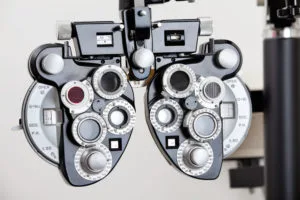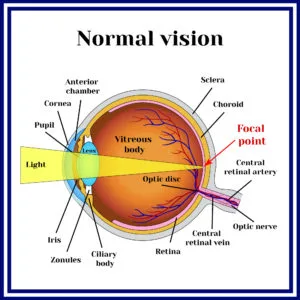What's Your Refractive Error? | Correcting Refractive Errors
July 29, 2017
 Almost everyone has a refractive error. A refractive error occurs when light can not be sharply focused on the retina.
Almost everyone has a refractive error. A refractive error occurs when light can not be sharply focused on the retina.
Common types of refractive errors are:
- Nearsightedness - also known as myopia
- Farsightedness - also known as hyperopia
- Astigmatism - a common secondary aberration in the focusing system of the eye
Technically speaking, your refractive error is the measurement of the power of the lenses needed to focus light on the retina. Sharply focused light results in clear vision.
Visual System of the Eye
For us to see well, the eye functions as a unit to focus light onto the retina. The retina is the light sensitive tissue which lines the inside of the eye (some call this the “back of the eye”).
Light rays enter the eye through the cornea, pupil, lens and vitreous before landing on the retina. The cornea retains about 75% of the total focusing power of the eye. The lens supplies the other 25%.
It is really the corneal surface that focuses or refracts light. Small changes to the corneal surface can result in dramatic changes in the eye’s ability to focus light. This now explains why a corneal abrasion can blur vision until healed. This also is how LASIK and the Raindrop Near Vision Inlay can work so well to correct your vision.
The pupil and vitreous have no direct influence on focusing light.
Once light is captured by the retina, electronic impulses are then sent via the optic nerve to the brain resulting in vision.
Correcting Refractive Errors
Glasses and contact lenses are often used to correct refractive errors, but glasses are expensive, can break and are often impractical to use in certain situations (e.g. sports). Contact lenses are also expensive, can cause corneal infections, can tear, fallout or get dirt underneath.
Laser vision correction, such as LASIK, can provide a long term alternative to contact lenses and glasses. LASIK works by changing the corneal surface. More specifically, it alters the curvature of the cornea to alter the refractive power of your eye - reducing or eliminating the need for glasses or contact lenses.
The Raindrop Near Vision Inlay also works by altering the corneal surface. A tiny clear inlay is inserted into the cornea producing a subtle change in the corneal surface. This is used to treat presbyopia - loss of near vision due to the natural aging process.
Older techniques such as radial keratotomy also “changed vision” by altering the curvature of the cornea. While LASIK has generally replaced RK, the basic ideas are the same; changing the corneal surface can result in improved vision without the need for glasses of contacts.
If you are ready to consider alternatives to glasses please call us (301.825.5755). My team and I look forward to meeting you.
Mark Whitten, M.D.
Vision Correction Surgeon
LASIK, Cataract & Raindrop
Shilpa Rose, M.D.
Vision Correction & Dry Eye Specialist
The material contained on this site is for informational purposes only and is not intended to be a substitute for professional medical advice, diagnosis, or treatment. Always seek the advice of your physician or other qualified health care provider.
These are surgical procedures and results may vary. While infrequent, complications can occur. Before your procedure, you will read an Informed Consent document which discusses potential complications and risks. Dr. Whitten will thoroughly review this information with you and answer your questions.



